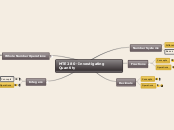MTE 280- Investigating Quantity
Number Systems
Different Systems
Our numerical system is the Hindu Arabic System. Other places and points in time may have other systems such as: Roman Numerals Different Bases Binary
Bases
Definitions Counting Numbers- positive integers, not including fractions or decimals and 0Digits- counting numbers, single symbolsTypes of Number Systems Different areas of the world may have ways of symbolizing numbers and counting. For example, America, and many other countries use Hindu-Arabic symbols under a base 10 counting system. Base 12 System0, 1, 2, 3, 4, 5, 6, 7, 8, 9, x, yEx: 1, 2, 3, 4, 5, 6, 7, 8, 9, x, y, 10. . .1x, 1yBase 10 System0, 1, 2, 3, 4, 5, 6, 7, 8, 9Ex: 1, 2, 3, 4, 5, 6, 7, 8, 9, 10, 11, 12Base 5 System *0, 1, 2, 3, 4Ex: 1, 2, 3, 4, 10, 11, 12Base 2 System0, 1Ex: 1, 10, 11, 100, 101, 110, 111, 1000* "10" is 1 and 0, NOT "ten"-----------------------------------------------------------------Single, Small Cubes = Ones = UnitsRectangular Block of 10 units = Tens = LongSquare of 10 Longs = Hundreds = FlatCube of 10 Flats = Thousands = Cube
Concepts
Fraction Models•Area Model•Set Model•Linear Model (a row or number line)*these are used to demonstrate the different concepts involving fractionsEquivalent Fractions- fractions that don't necessarily have the same denominator, but equal the same percentage of their wholeEx: 1/4=2/8, these can be equivalent because they are the same ratio
Operations
Adding Fractions•Area Model•Numberline Model•Unit SquareHow to use a Unit Square:https://education.ti.com/~/media/682BA8BCC0FD491298991D9F0189A85CSubtracting Fractions•Area Model•Numberline Model•Unit SquareHow to use a Unit Square:http://mps.milwaukee.k12.wi.us/MPS-English/CAO/Documents/RtI-Academics/math-intervention-4NF3b_Decomposing_Fractions.pdf
aDecimals
Concepts
Place Value when working with decimals is slightly shifted to the left when looking at the numbers behind a decimal. The decimal is used as a ones place. For example, the first number after the decimal is in the tens place.How to Pronounce Decimals:http://www.themathpage.com/arith/decimals-2.htmImproper Fractions/Mixed Numbers Ex: 1 and 1/2Equivalent FractionsEx: 1/2 = 2/4
aOperations
When using base 10 block to add, subtract, multiply or divide decimals, flats represent 1 whole, flat are equal to a tenth, units are hundredths. Method such as 10 block grid papers can also be used for these operations.Remember: The ones place before the decimal can be seen as a a number of tenths. Ex: 2.0 = 20 tenths
aProperties
Properties of AdditionClosure Property of Addition- The sum of two addends is a whole number.Commutative Property of Addition- Changing the order of the addends of an equation does not change the sum.Associative Property of Addition- Changing the grouping of the addends of an equation does not change the sum.Identity Property of Addition- Adding zero to a whole number does not change the number.Properties of Subtraction Identity Property of Subtraction-Subtracting zero from a whole number does not change the number.Properties of Multiplication Commutative Property of Multiplication- Changing the order of the factors of an equation does not change the product.Associative Property of Multiplication- Changing the grouping of the factors of an equation does not change the product.Distributive Property of Multiplication- "The sum of two numbers times a third number is equal to the sum of each addend times the third number."Identity Property of Multiplication- Any factor multiplied by one is that factor.Distributive Property of Multiplication over Add/Sub
aModels
Addition Problem TypesSet Model of Addition- Combining two distinct sets of objects.Number Line Model of Addition- Using a number line to represent the combination of abstract sets.Subtraction Problem TypesTake-Away Model of Subtraction- Removing an set from another set. Missing Addend Model of Subtraction- Using subtraction to determine a missing value in an addition equation.Comparison Model of Subtraction- Finding the difference between two sets. Number Line Model of Subtraction Multiplication Problem TypesProduct-UnknownSet Group Size UnknownDivision Problem TypesMeasurement Division- Finding out how many individuals can fit in a set amount of groups.Partition Division- Finding out how many are in a set or group.
Algorithms
Algorithms for Addition/SubtractionTraditional Method48 48+ 33 - 33_____ _____81 15Partial Sums Method 48 1: Add/Subtract the 4 and 3 as they are in their tens place. + 33 (Ex. 40+30=70)_____ Step 2: Add/Subtract the 8 and 3 as they are. 70 + 11 _____ Step 3: Combine your two sums or find the difference.81 (Ex. 70+11=81)Expanded Notation 40 + 8 Step 1: Write each addend in expanded form.+ 30 + 3 Step 2: Add or subtract by place value.____________ 70 + 11=81Algorithms for Multiplication Traditional Method4312 x____ 86430 +____516Partial Products4312 x____80------> 2x406--------> 2x340------> 1x43--------> 1x3
aStrategies
Strategies Number LinesBase 10 Blockshttp://illuminations.nctm.org/lesson.aspx?id=3760https://www.math-drills.com/baseten.phpAddition - http://www.crewtonramoneshouseofmath.com/Teaching-Addition-With-Base-Ten-Blocks.htmlSubtraction -http://www.helpingwithmath.com/printables/worksheets/numbers/1nbt2-place-value03.htmMultiplication - https://learnzillion.com/lesson_plans/5253-multiply-by-multiples-of-10-with-base-ten-blocksDivision - DecompositionAddition and Subtractionhttps://www.google.com/amp/s/www.whatihavelearnedteaching.com/composing-and-decomposing-numbers-for/amp/
aNumber Theory
Number theory includes concepts such as prime numbers and congruence congruence.Prime Number- "A prime number is a whole number greater than 1, whose only two whole-number factors are 1 and itself."-Google
Concepts
Integer: "properties including opposites, positive, negative, number line, and signs"* Positive Integers are greater than 0* Negative Integers are less than 0* Integers are opposite of each other if they have opposite signs and are the same distance from 0 on the number line Absolute Value: the value of a number regardless of its sign* How far a number is away from zero* Designated by |x| Multiplying Positive and Negative Integers How I learned to tell what sign the product of two Integers would be: https://goo.gl/images/dDeZtT
a